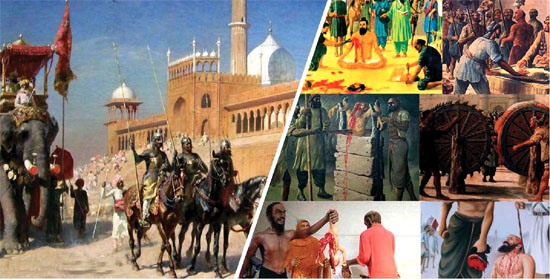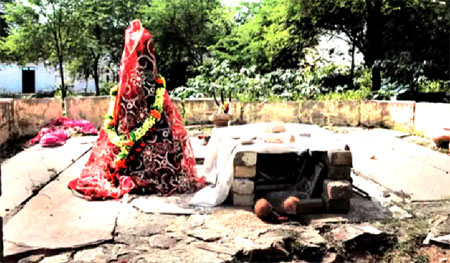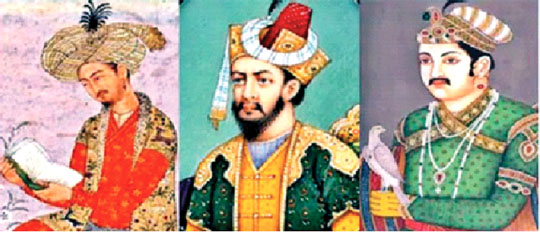
In the light of the fact that partial changes were made in the syllabus by CBSE, it is necessary to rewrite history. Without it, complete national consciousness cannot be developed for the future generation
Education is the backbone of any society and nation. The entire future of that nation and its generations depends on it. It is through education that national and cultural values are developed and this must be done. The spirit of mutual unity, peace, cooperation and harmony can also be strengthened through education. Not only pre-Independence but unfortunately even after the attainment of Independence, only colonial, Leftist, pseudo-secularist and Macaulay-inspired thinking and mentality have dominated the education system. So much so that even today their poisoning of the educational socio-cultural environment often not only becomes toxic but also deepens and strengthens the line of division.
With great skill and deviousness, they have planned a conspiracy and a vicious circle to separate the young generations of the country from their roots, traditions, high ideals and life values. As a result, the inferiority complex towards the past, anger and dissatisfaction with the present and doubts, mistrust and hallucinations about the future is becoming the main trend and identity of today’s youth. But these Leftists and so-called intellectuals present and glorify this rootless, non-national thinking with the well-known arrogance by linking them with “India’s destiny”. Whereas de-Indianisation of education is the root cause of most of India’s problems and Indianisation is the only solution.
Changes in Course Books Needed
From History, Political Science, and Sociology to Social Science in almost all the classes, there is a need for radical changes at every level in the textbooks and syllabus of most subjects like Hindi, and English. The text materials (contents) of all these subjects are utterly monotonous. The curriculum is far from the country’s nature, environment, tradition and background. It is completely detached from themselves, their country and culture and is incapable of fulfilling daily needs. In these, to raise class and regional consciousness and different identities, such subjects have been selectively inserted, which are the biggest obstacle in the path of national unity and integrity, and on the other hand, religion-sect. India has been described as a multicultural country with different cultures. In fact, ‘mixed’ or ‘composite culture’ is such a lie and rhetoric, which is repeatedly fabricated, tossed and redeemed like slogans by Leftist historians and academics. Even knowingly, this truth is grossly neglected that India’s culture, which sees unity in diversity, is one, which the whole world has been calling since ancient times Sanatan culture, Hindu culture or Indian culture. Unfortunately, even today Westernisation is considered the only criterion of progress, levelness and modernity in the education world. Whereas today the need is more than that. It is that one’s own identity should be assimilated by making it era-suited and that which is outside country-suited.
Is it not true that evil practices like child marriage, sati-pratha, purdah-pratha, and untouchability entered and became prevalent in India as a means of protection from Turk, Mughal and Arab invaders? Before the arrival of heretics and foreign invaders, why not even a single instance of the practice of these evil practices is found in India?
Assumptions Prevailed Over Facts
It is a well-known and widely accepted fact that history happens and is not dictated. But unfortunately, in the name of writing History, the well-planned conspiratorial and sponsored campaign for the honour of us Indians was carried out during the period of Independence. It continued uninterrupted even after the attainment of Independence. Even in independent India, no special initiative and effort were made in the direction of writing helpful history to protect the self-respect of the nation. Rather, like British India, in independent India too, instead of facts and evidence, only assumptions and implicit implications were nurtured. The events of history were compiled, detailed and analysed on the guidelines of ideology and party. Historians, archaeologists and researchers, who uphold the pre-decided opinions and conclusions, were rewarded and encouraged by placing them in the top positions of various educational institutions and universities. Traditional sources, ancient scriptures – Vedas, Puranas, epics – and evidence materials obtained from excavation and all concrete and available facts were grossly neglected in the History writing and compilation of materials. Folk literature and folk memories were put on hold. The descriptions written by the invaders or the people travellers, who were in their shelter, were the most authentic source or basis of history and arbitrary interpretations were given, and desired establishments were given. In place of rational, neutral, independent thinking and objective discussion, foreign opinions, personal insistences and ideas of families who controlled the power system for a long time, Leftist and fabricated beliefs were presented and glorified like true events of history. Not only this, institutions like the Academic Literary to Historical Research Council were made the den of the ideological camp. Instead of dialogue, monologue and instead of discussion, speech began to receive encouragement. In the textbooks, such incidents and details were discussed in detail and selected, which prove to help destroy the eternal personality of India. Even the heads of a few leaders began to be tied to the collective achievement of the country’s independence. Different types of efforts in different provinces and regions of the country for Independence and innumerable and great heroes who participated in it were pushed into the pit of oblivion. Do not know how many such revolutionaries and freedom fighters were there, who were grossly neglected, whose mountain-like personality and contribution were presented as mustard. They were summed up in a few pages. A vicious circle was created to distort the personality, character and historical contribution of some. How many such youths will be there today, whom Nana Fadnavis, Babu Kunwar Singh, Ram Singh Kuka, Vasudev Balwant Phadke, Chapekar and Savarkar brothers, Lala Hardayal, Madanlal Dhingra, Madam Cama, Barindra Kumar Ghosh, Shachindranath Sanyal, Satyendra Nath Basu, Khudiram Bose, Prafulla Chaki, Yatindra Nath Das, Batukeshwar Dutt, Ullaskar Dutt, Bhupendranath Dutt, Rash Behari Bose, Shyamji Krishna Varma, Bhai Parmanand, Master Da, Raja Mahendra Pratap, Udham Singh, Roshan Singh, Rajendra Lahiri, etc. Can you remember the name? Even those whose names are remembered, their work and contributions were not thrown into the textbooks of history in detail. The socio-cultural historical aspects and effects, contexts and ideals of their contribution were not clarified. The importance given to Bhagat Singh, Sukhdev, Rajguru, Chandrashekhar Azad, Ramprasad Bismil, and Ashfaqullah Khan by the public, art and cinema, was the same importance given to them in history books and the academic world? Was the importance and contribution of Subhash Chandra Bose right, balanced and fair discussion? Wasn’t an effort made after Independence with great planning to prove that we got freedom only because of the non-violent movements led by Congress? The line of ‘De di hame azadi bina khadag bina dhaal’ was being sung and repeated. Whereas the fact that the then Prime Minister of Britain, Clement Attlee, who had signed the Treaty of Independence, during his visit to Kolkata in 1956, in conversation with Justice PB Chakraborty, Acting Governor of West Bengal, exposed the truth that for British rule Netaji Subhash Chandra Bose’s movement and naval mutiny were more challenging for him. They feared that a large number of British might lose their lives in the violent movements caused by Netaji’s military activities, naval mutiny and growing resentment and discontent in the Indian Army. Therefore, the British Government decided to abruptly liberate India in 1947, even though the Quit India movement started under the leadership of Gandhiji in 1942 had almost completely blunted. Wouldn’t it be appropriate that instead of treating someone as inferior or important, all the freedom fighters should get due respect in the pages of history? Isn’t this the cruellest injustice done to the freedom fighters and immortal souls who sacrificed their lives for freedom, for the nation, happily accepted the noose of the gallows, life imprisonment and the torture of black water? Is it that the naming of all government schemes, programmes, monuments, roads and institutions was limited to a few leaders and their descendants? It is the need of the hour that by correcting the mistakes of the past in the present, the heroes of the marginalized history should find a place on the front pages. It’s too late, but justice should be done to them!
Glorification of Invaders
It is also a matter of great surprise that on the one hand, from the point of view of national integration, devotion centres, twelfth Jyotirlingas, 52 Shaktipeeths, Kumbh Mela events, forts, cities, monasteries and temples, which bind the whole of India in the thread of unity. The architectural, historical-cultural sites, important events, glorious Indian empires, successful dynasties, their chronology, family trees, public welfare works and their unprecedented achievements were grossly neglected, while on the other hand grand, fascinatingly exaggerated interpretations of foreign invaders like the Ghulam dynasty, Khilji dynasty, Tughlaq dynasty, Sayyid dynasty, Lodhi dynasty, Mughal dynasty, their war-details and the alleged forts, mosques and architectural arts built by them. Despite knowing the fact that the countries from which these invaders came from, there is not a single excellent and remarkable specimen of architecture built by their predecessor or successor rulers in those countries. It is also unfortunate that the discussion of all the influential States and dynasties like- Cholas, Chalukyas, Palas, Pratiharas, Pallavas, Parmaras, Maitrakas, Rashtrakutas, Vakatakas, Karkot, Kalinga, Kakatiya, Satavahana, Vijayanagara, Odeyar of Mysore, Ahom of Assam, Naga, Sikh etc is almost negligible in our textbooks and academic discourses, except for a few exceptions such as the Mauryas, the Guptas and the Marathas in modern times; while during their long reign, many well-planned cities were established, long wide roads were built, well-known educational centres were established, forts, monasteries and temples were built to be included in the cultural heritage of the world. Shouldn’t the information about such cultural heritage be given to the younger generation? In the name of Ganga-Jamuni tehzeeb, where there was a unilaterally planned attempt to cover up the cruelties and brutalities of foreign-heretic invaders and rulers. At the same time, an organised institutional effort was carried out under the pretext of secularism to characterise rulers like Akbar, Aurangzeb, and Tipu Sultan as more heroic, magnificent, superior, and benevolent than Raja Krishnadev Rai, Maharana Pratap, Chhatrapati Shivaji, and Bajirao Peshwa. It is like repeatedly raging the sufferings of the majority of the country. Such shameless glorification of those who have killed lakhs and crores and destroyed temples, dharamshalas and libraries without cause is a gross insult not only to the majority of India but to humanity as well. On the one hand, there is no name left of Hitler in Germany due to the barbaric atrocities committed on the Jews, the whole of Europe and America remains full of atonement for the atrocities committed against the Jews in the past, and on the other hand in India even today. There are a large number of people who are proud of the terrorists-invaders like Ghori, Ghazni, Khilji, and Timur, they don’t mind naming their children after them, and often they share intimacy and connection with them and their neighbours and sorrows. On the day of happiness, there is a sense of distance and animosity towards the partners. The real obstacle in the way of building harmony, goodwill and brotherhood is not the writing and description of true history, but this medieval mentality of taking pride in the terrorists and invaders. On the day when true, right and balanced sense of enemy-friend, victory-defeat, honour-humiliation, pride-defamation, inferiority-superiority will develop within all the countrymen, on that day unity from one end of the society to the other, The spirit of cooperation and harmony will automatically develop. It is through the textbooks of history that every community has to be told and explained again and again that change of religion does not change ancestors, culture does not change due to change in worship or system of worship, and common dreams and aspirations do not change by changing faith. There have been many such occasions in history when there was a shared feeling of the pain of defeat when the shared moments of joy and pride came alive. We have to take the nation as paramount, rising above religious beliefs, and make mutual agreement and disagreement on the heroes-villains of the past in an absolute sense.

The glorious past of East, West and South India has found a very little place in the pages of history. Rather, the entire history of medieval and modern India has been confined around the Delhi Sultanate, Mughal dynasty, East India Company, British lords and generals and leaders of contemporary Congress in the name of freedom movement
Which Indian would not be proud of all the personalities like Rahim, Raskhan, Dara Shikoh, Bahadur Shah Zafar, Ashfaqullah Khan, Khan Abdul Ghaffar Khan, Mohammad Usman, Abdul Hameed, APJ Abdul Kalam or presently Arif Muhammad Khan! But can there be any doubt that the stubbornness and passion to preserve the name of Bakhtiyar Khilji, who destroyed and corrupted the biggest temple and source of knowledge like Nalanda University, has any place in a free, modern and progressive India? And shouldn’t it be justified? Is it not true that the facts and events have been described in our textbooks of history in such a way that the names of foreign invaders are remembered, but the names, faces and voices who surrendered to the nation do not emerge? In the enumeration of Indian kings, we hardly remember any other names except a few names like Chandragupta, Ashoka, Vikramaditya, Harshavardhana, Prithviraj Chauhan, Maharana Sanga, Maharana Pratap, Chhatrapati Shivaji, Bajirao Peshwa! Whereas Bindusara, Pushyamitra Sunga, Kanishka, Samudragupta, Skandagupta, Mahendra Shatakarni, Gautamiputra Shatakarni, Mahendravarman, Narasimhavarman, Mayuravarman, Ravi Varma, Kirtivarman, Rajaraja Chola, Rajendra Chola, Nagabhatta Pratihara, Mihirbhoja, Harihara Raya, Bukkada Raya, Lalitaditya Muktapeed, Krishnadeva Raya, Cheraman Perumal, Bappa Rawal, Maharana Kumbha, Hammirdev Chauhan, Lachit Borphukan, Maharaj Suheldev, one after the other, Indian history is full of heroic and glorious achievements of mighty and majestic kings. Leave aside their work, even the names of states and capitals are not discussed properly in the textbooks. As a result, the younger generation is ignorant and unfamiliar with its own glorious past and history.

Sati Started Due to Muslim Invaders
Believe it or not, after reading the history textbooks of different classes, the impression is made that the saga of India is only a saga of defeat, that India does not have a single concrete example of inspiration and masculinity, and that no soldiers from anywhere. The whole of India was plundered, trampled and defeated, and either returned with a lot of goods and decorations or kept on ruling us until some other invader came, that we were backwards, regressive, conservative, superstitious countries and societies divided into castes are only. At the same time, the reasons and immediate scenarios of those customs and superstitions prevalent and entering the Indian society have not even been cleverly mentioned. Is it not true that evil practices like child marriage, sati-pratha, purdah-pratha, and untouchability entered and became prevalent in India as a means of protection from Turk, Mughal and Arab invaders? Before the arrival of heretics and foreign invaders, why not even a single instance of the practice of these evil practices is found in India? Whereas innumerable examples of brides being chosen based on virtues, women leading the front in the war, becoming kings from every caste and having many revered saints from allegedly deprived or Dalit society can be seen in ancient Indian history. The truth is that history textbooks and curricula are one-sided and unbalanced. They are mostly Delhi-centric. The country is not limited only to the state, the capital and the sultans rulers and a few faces mounted on it. It includes the land, rivers, mountains, forests, groves and above all the common people, their struggles, joys and sorrows etc. The complete history of India is missing from our textbooks. Our country was hardly given any space. The glorious past of East, West and South India has found a very little place in the pages of history. Rather, the entire history of medieval and modern India has been confined around the Delhi Sultanate, Mughal dynasty, East India Company, British lords and generals and certain leaders of contemporary Congress in the name of the freedom movement. In this holy and golden hour of the elixir of freedom, we should work and think seriously about the rewriting of history in the direction of developing and establishing a true, holistic, equitable and balanced sense of history or sense of India. Without it, true, holistic and complete national consciousness cannot be developed within the future generation.
Courtesy : ORGANISER














